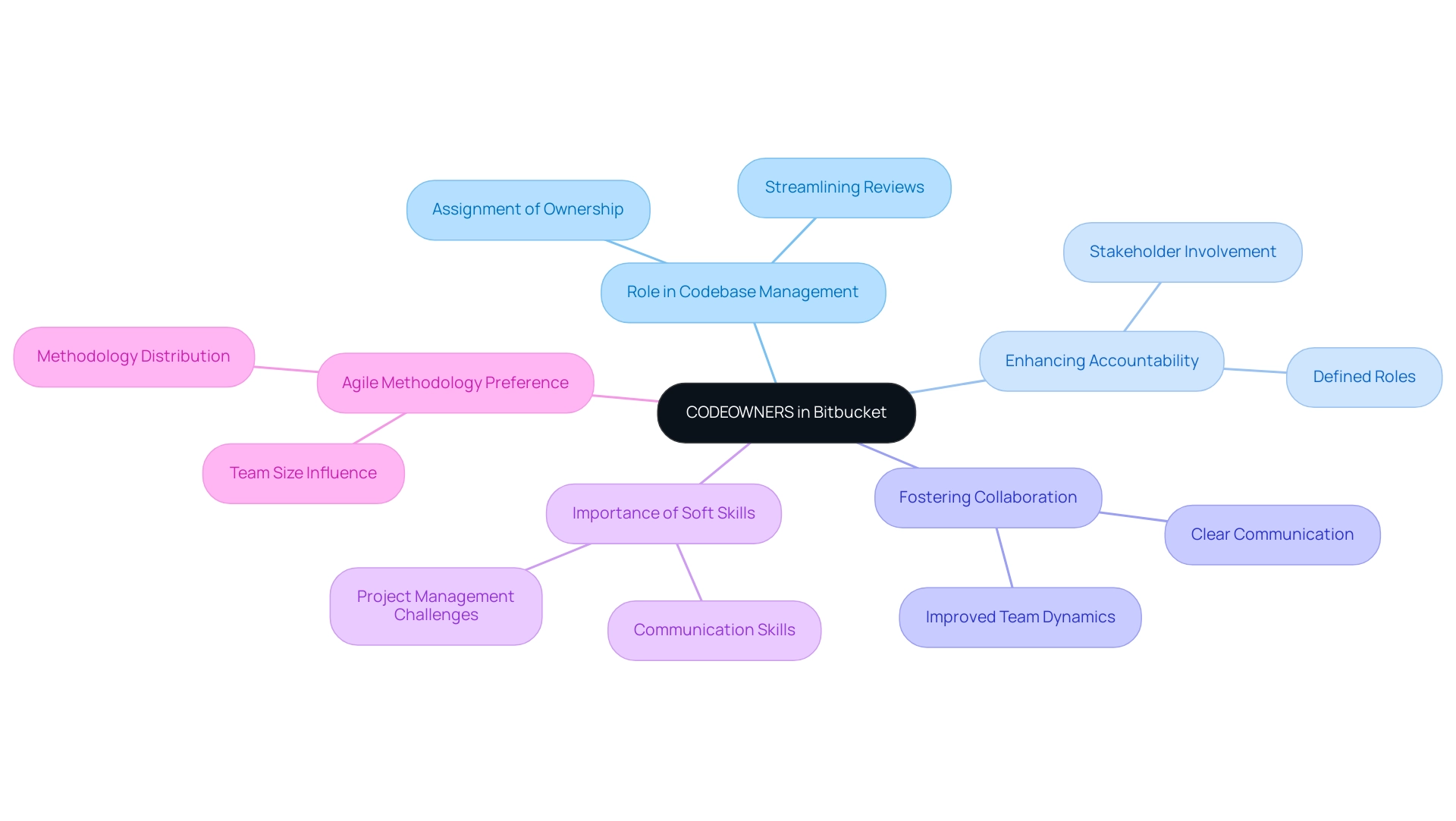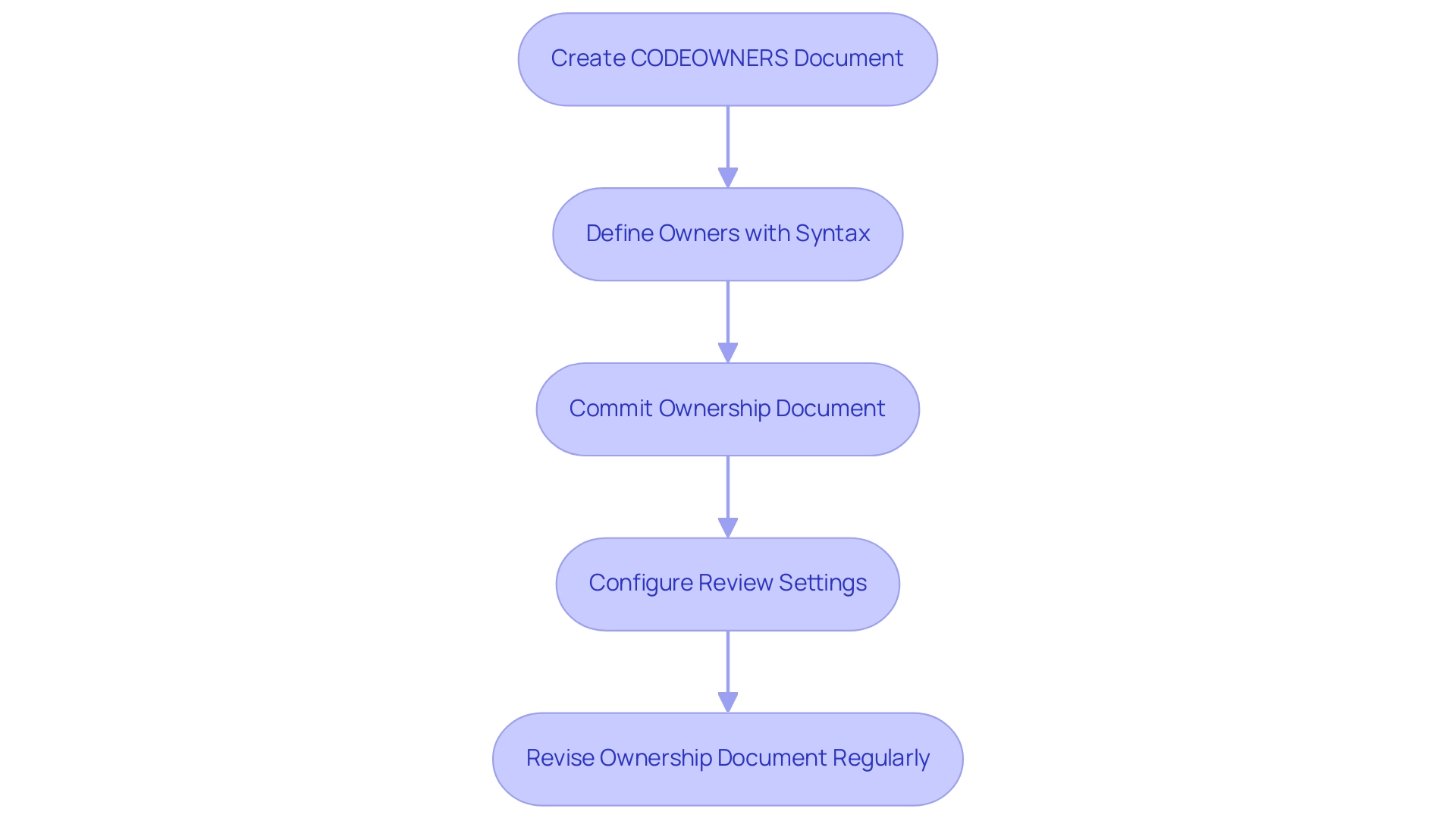Overview
CODEOWNERS in Bitbucket are files that assign responsibility for specific parts of a codebase to designated individuals or teams, enhancing accountability and streamlining the code review process. The article emphasizes that this structured approach not only facilitates effective collaboration and communication among developers but also helps prevent bottlenecks in reviews, thereby improving overall project management and software quality.
Introduction
In the fast-evolving landscape of software development, the effectiveness of a team's workflow hinges on clear communication and defined responsibilities. The CODEOWNERS file emerges as a pivotal tool within Bitbucket repositories, ensuring that every segment of the codebase is managed by the right individuals or teams. By establishing ownership, organizations can streamline code reviews, foster accountability, and enhance collaboration, ultimately leading to improved project outcomes.
As teams navigate the complexities of modern development practices, understanding and implementing CODEOWNERS becomes essential for optimizing efficiency and maintaining high standards in code quality. This article delves into the significance of CODEOWNERS, offering practical guidance on setup, potential challenges, and best practices for maximizing its impact within development teams.
Understanding CODEOWNERS: Definition and Purpose
The CODEOWNERS file plays a crucial role in Bitbucket repositories by assigning code owners in Bitbucket who are responsible for specific segments of the codebase. This assignment of ownership is crucial for streamlining reviews, ensuring that the appropriate stakeholders are involved whenever modifications are made. Such a structured approach not only enhances accountability but also fosters improved collaboration among group members.
This is particularly important given that 80% of developers emphasize the significance of soft skills, such as communication, in effectively tackling project-related challenges. For groups aiming to improve their development processes and maintain strict criteria in code management, understanding the importance of code owners in Bitbucket is essential. Furthermore, a recent case study indicates that smaller teams (1-6 members) show a 78% preference for Agile methodologies, which suggests that having defined roles like those set by designated owners can significantly enhance the effectiveness of Agile project management.
As highlighted by Samantha Spiro, Content Manager and Chief Editor at Hutte,
Bringing the written word to life is the name of her game,
reflecting the transformative power of clear ownership in coding practices. Additionally, with current trends in software developer engagement rates emphasizing the importance of effective coding practices, the use of code owners Bitbucket files is more relevant than ever.

Setting Up CODEOWNERS in Bitbucket: A Step-by-Step Guide
Establishing code owners in Bitbucket is a straightforward process that enhances accountability and streamlines your code review procedures. Start by creating a document named CODEOWNERS in the root, .bitbucket, or docs directory of your repository. Next, define the owners using the syntax: path/to/file @username or path/to/directory @team name.
This specification clarifies which users or teams are accountable for the items or directories listed. For instance, just as Heroku manages data by storing backups of the Postgres database in the U.S., even when the data center is located in Europe, it’s essential to have clear ownership in your repository to manage code effectively. After identifying the owners, commit the ownership document to your repository.
Once committed, Bitbucket automatically requests reviews from the designated owners whenever changes occur in the specified paths. Additionally, to prevent automatic assignment of Code Owners to pull requests, users can adjust settings in the repository, ensuring that no reviewers are assigned to new or updated pull requests, allowing for manual management of reviewers. It's vital to frequently revise the ownership document to represent any alterations in group roles or project frameworks, maintaining its continual significance and efficiency.
As Bill Joy aptly puts it, 'So if only files in the JVM sub-directories are in the pull request, Bill Joy will be the owner of the project.' By executing these steps, groups can effortlessly incorporate code owners Bitbucket into their projects, resulting in enhanced accountability and effective review processes.

The Impact of CODEOWNERS on Code Reviews and Collaboration
The execution of ownership files greatly improves reviews and group collaboration, especially when combined with Kodezi's AI-driven automated builds and testing. By establishing clear ownership, teams can ensure that the right individuals participate in the review process, accelerating feedback loops and enhancing quality. For instance, reviewing 10 features typically requires a total of 20 hours; with defined CODEOWNERS and Kodezi’s automated testing catching potential bugs before they multiply, this time can be optimized further.
Kodezi's automated testers utilize advanced algorithms to analyze changes in real-time, identifying issues such as smells and potential vulnerabilities, which helps maintain high quality. This clarity of ownership reduces miscommunication and oversight, as owners are more likely to engage with the segments they oversee. Additionally, it encourages a culture of accountability, motivating group members to take responsibility for their contributions.
A pertinent testimonial from a pleased user emphasizes, 'Kodezi's automated testing has transformed our review process, allowing us to catch bugs early and enhance our overall efficiency.' This structured approach not only enhances collaboration but also drives overall productivity. Moreover, tracking code review velocity—measured by the amount of code reviewed over a specific timeframe—can further underscore the strategic advantage of adopting ownership roles alongside Kodezi's automated features, allowing teams to set realistic expectations and allocate resources more effectively.
Thus, integrating Kodezi with the implementation of code owners Bitbucket guidelines is essential for modern software development, as it ensures a more efficient and high-quality codebase.
Common Pitfalls and Challenges with CODEOWNERS
Implementing code owners Bitbucket files can significantly enhance project management, but it is essential to recognize and navigate potential pitfalls. A primary concern is the risk of overloading specific individuals or groups with excessive responsibilities, leading to review bottlenecks. For example, in bigger groups, it is not unusual for a complicated pull request (PR) to need up to six reviews if it involves documents managed by multiple sets of ownership rules.
This frequently leads to unnecessary postponements before software can be shipped. Moreover, if the ownership file is not frequently refreshed, it can result in outdated code owners Bitbucket assignments, causing confusion among group members and extending the review process. It is crucial that the code owners in Bitbucket possess the requisite expertise to effectively evaluate the code they are responsible for.
The human desire for ownership is legitimate, and while designated individuals can assist in clarifying responsibilities, they should not foster unnecessary gatekeeping that reduces group agency. An alternative approach to managing responsibilities is through the use of rulesets, which can offer advantages such as statuses and better discoverability without requiring admin access. By proactively tackling these challenges and considering adaptable management strategies, groups can improve their implementation, ensuring a smoother and more efficient workflow.
As noted by content writer Chatty Garrate,
Software developers, management teams, and individual users can all utilize code owners bitbucket to enhance collaboration and improve workflow.
Embracing this perspective can help mitigate the common challenges associated with code ownership, promoting a more agile development environment.
Best Practices for Managing CODEOWNERS in Your Projects
To ensure optimal management of ownership files in your projects, implement the following best practices:
- Perform routine evaluations and revisions of the ownership document to ensure it remains in sync with group dynamics and project advancements. This is vital, as confirming that the group mentioned in a CODEOWNERS document has write access to the repository is fundamental for effective collaboration with code owners Bitbucket. Limit the number of owners assigned to each document or directory to minimize the risk of review bottlenecks, which can hinder project momentum. Foster an environment of open communication amongst team members to enhance engagement, ensuring that owners fully understand and embrace their responsibilities.
- Adopt clear and consistent naming conventions for paths and code owners in Bitbucket's CODEOWNERS document, which will enhance its readability and facilitate easier understanding. Provide targeted training and resources for owners to empower them in conducting effective reviews. Referencing the case study titled 'Syncing Code Owner Approval Rules,' groups can learn the importance of managing code owners in Bitbucket by deleting outdated approval rules and creating new ones for changed files listed in the CODEOWNER file. This approach ensures that code owner approval rules are always up-to-date, improving the efficiency of the code review process.
- By applying these strategies, including the understanding that code owners can be defined in public repositories with GitHub Free and GitHub Free for organizations, teams can fully leverage the capabilities of CODEOWNERS, resulting in enhanced collaboration, accelerated development cycles, and higher code quality.
Conclusion
Establishing a CODEOWNERS file within Bitbucket repositories is not merely a technical necessity; it is a transformative strategy that optimizes team workflows and enhances project outcomes. By designating clear ownership of code segments, teams can streamline code reviews, foster accountability, and enable effective collaboration. This structured approach not only mitigates miscommunication but also empowers developers to take responsibility for their contributions, leading to improved efficiency and high-quality code.
The implementation of CODEOWNERS is complemented by best practices that ensure its ongoing relevance and effectiveness. Regular updates to the ownership assignments, limiting the number of owners per file, and fostering open communication are essential in maintaining a productive environment. Moreover, integrating tools like Kodezi can further amplify the benefits of clear ownership by automating testing and feedback processes, ultimately driving greater productivity and code quality.
In the fast-paced world of software development, adopting the CODEOWNERS strategy is crucial for organizations striving for excellence. By embracing this practice, teams can navigate the complexities of modern development with confidence, ensuring that every code change is managed effectively and collaboratively. Thus, leveraging CODEOWNERS is not just about assigning responsibility—it's about cultivating a culture of ownership that propels projects forward and sets the stage for successful outcomes.
Frequently Asked Questions
What is the purpose of the CODEOWNERS file in Bitbucket repositories?
The CODEOWNERS file assigns code owners responsible for specific segments of the codebase, streamlining reviews and ensuring appropriate stakeholders are involved in modifications, which enhances accountability and collaboration.
Why is it important to have code owners in a development team?
Having code owners is crucial for improving development processes, maintaining strict criteria in code management, and fostering effective communication, which is emphasized by 80% of developers as a key soft skill.
How do smaller teams benefit from having defined roles like code owners?
Smaller teams (1-6 members) show a 78% preference for Agile methodologies, suggesting that defined roles set by designated owners can significantly enhance the effectiveness of Agile project management.
How can one establish code owners in Bitbucket?
To establish code owners, create a document named CODEOWNERS in the root, .bitbucket, or docs directory of your repository, then define the owners using the syntax: path/to/file @username or path/to/directory @team name, and commit the document to the repository.
What happens once the CODEOWNERS document is committed to the repository?
Once committed, Bitbucket automatically requests reviews from the designated owners whenever changes occur in the specified paths.
Can users manage reviewer assignments manually in Bitbucket?
Yes, users can adjust repository settings to prevent automatic assignment of Code Owners to pull requests, allowing for manual management of reviewers.
How often should the CODEOWNERS document be revised?
The ownership document should be frequently revised to reflect any changes in group roles or project frameworks, ensuring its continued significance and efficiency.




